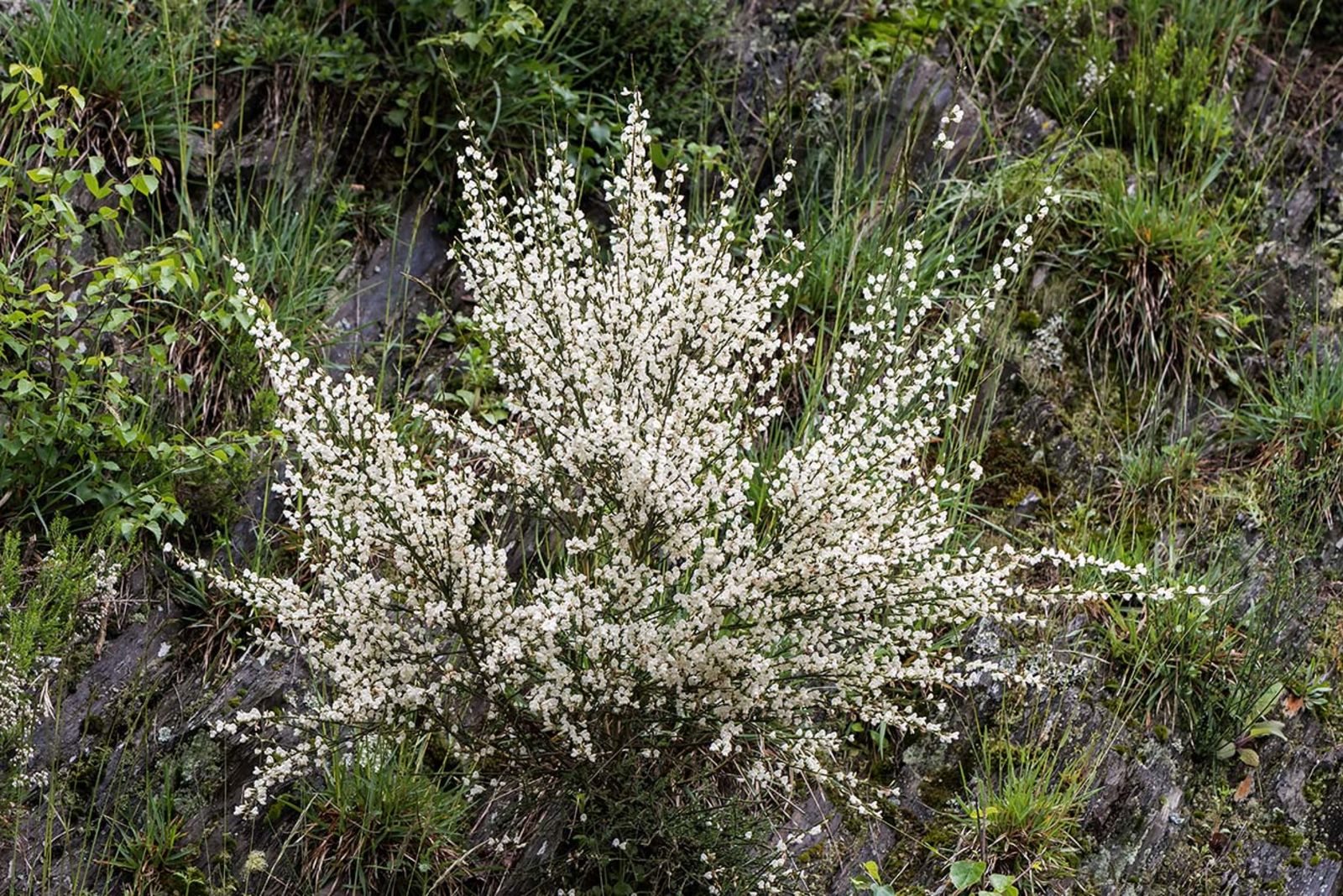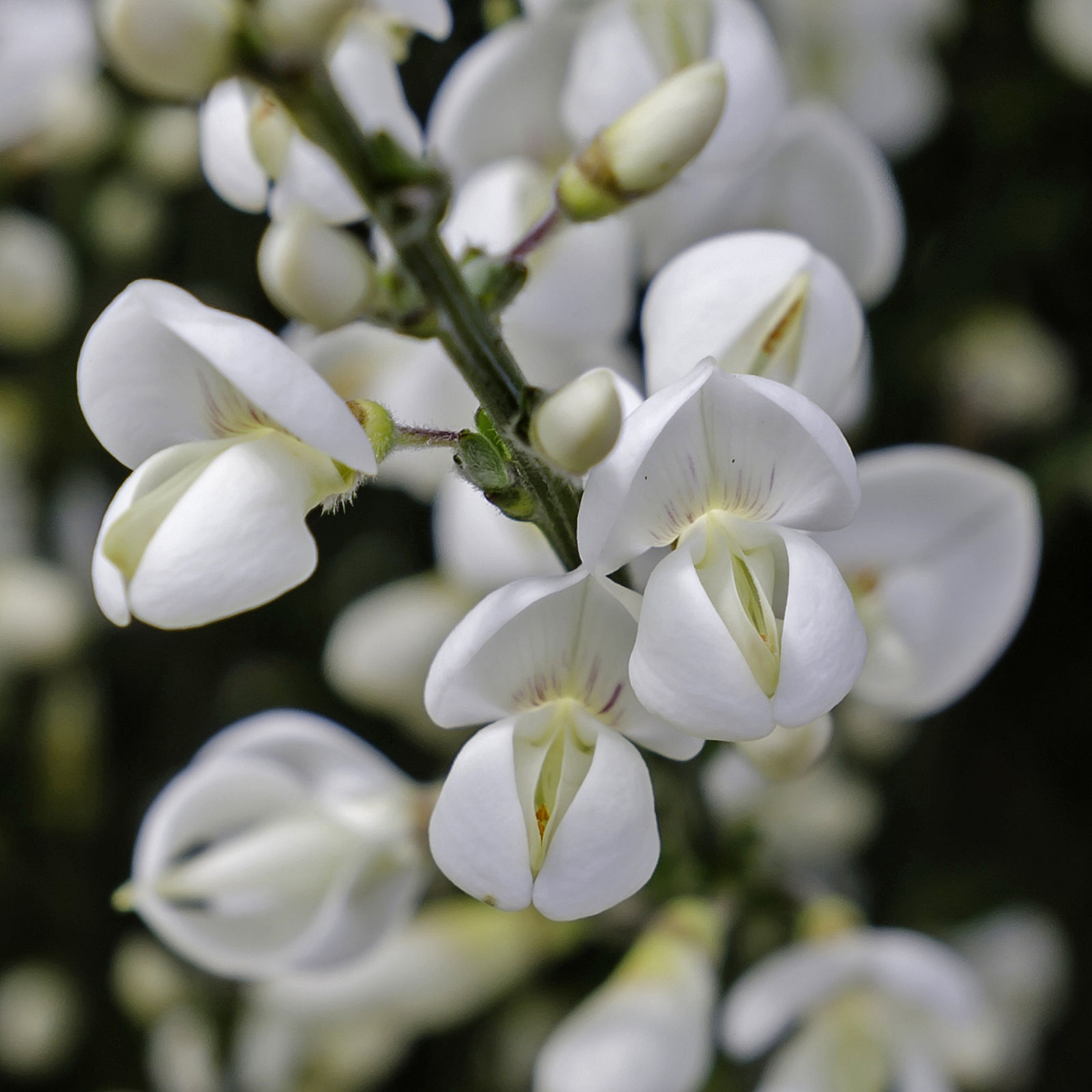White Broom
cytisus multiflorus
Also known as: ["Spanish Broom","White Dyer's Broom"]
Overview
A deciduous shrub native to Spain and Portugal, known for its profuse white flowers and slender, green stems.
Benefits & Perks
["long-flowering","deer resistant","wildlife attractant (bees, butterflies, birds)","drought tolerant"]
Botanical Classification
| Phylum: | Magnoliophyta |
| Class: | Magnoliopsida |
| Order: | Fabales |
| Family: | Fabaceae |
| Genus: | Cytisus |
| Botanical Name: | Cytisus multiflorus |
Plant Characteristics
Basic Information
- Category: Shrubs
- Suitable Location: outdoor garden bed in a sunny, open area
- Suitable For:
- Is Weed: No
- Allergenicity: low
Environmental Needs
- Climate: {"temperatureRange":"5–35°C"}
- Hardiness: {"zones":"7–9"}
- Misting: rarely required
- Drainage: Fast-draining to prevent waterlogging.
- Soil Type: Well-draining, sandy loam with some organic matter; avoid heavy clay soils.
Maintenance Level
- Maintenance Level: moderate
- Toughness Level: high
- Pruning Frequency: Annually, immediately after flowering; light shaping can be done in late winter if needed.
- Pruning Intensity: Moderate; remove up to one-third of old growth to rejuvenate the plant.
Care Details
Ideal Sunlight Coverage:
Full sun (6–8 hours of direct sunlight daily); tolerates partial shade but may produce fewer flowers.
Sunlight Tolerance Tips:
Acclimate plants gradually to intense sunlight if moved from shade; protect from harsh midday sun in hot climates; ensure good air circulation to prevent sunburn.
Care Requirements
Care Difficulty
moderatemoderate
Sunlight
full sun
Rotate plant for even light exposure; use shade cloth in extreme heat; avoid placing in drafty areas.
Watering
every 7–10 days during active growth, less frequently in winter
Water thoroughly but infrequently; ensure soil dries between waterings; avoid overwatering to prevent root rot.
Soil
well-drained, sandy or loamy soil
pH: Slightly acidic to neutral (pH 6.0–7.0).
Use raised beds in heavy soils; mulch with pine needles or bark to maintain acidity; avoid overwatering.
Temperature
Prefers cool to moderate temperatures (60–75°F or 15–24°C); can tolerate mild frosts but avoid prolonged freezing.
Avoid sudden temperature fluctuations; protect from cold drafts; ensure good air circulation in hot weather.
Fertilizing
every 4–6 weeks during spring and summer
Fertilize sparingly; avoid feeding during dormancy; water before and after applying fertilizer.
Propagation
Methods
Softwood or semi-hardwood cuttings taken in late spring or early summer.
Step-by-Step Propagation Guide
- Take 4–6 inch cuttings.
- Remove lower leaves.
- Dip in rooting hormone.
- Plant in medium.
- Maintain humidity.
- Transplant when rooted.
Best Time: Late spring to early summer when new growth is firm but not woody.
Environment
Warm (65–75°F or 18–24°C), humid, and partially shaded environment.
Medium
Well-draining mix of peat and perlite or cactus mix.
Hormone
Rooting hormone is recommended for faster and more reliable rooting.
Timeline
Roots typically form in 4–8 weeks; plants may take a full growing season to establish.
Tools Needed
Pruning shears, rooting hormone, small pots, misting spray bottle, plastic bags or propagation dome.
Quick Tips
Use sharp, sterile tools; maintain consistent moisture; provide bottom heat if possible.
Pruning & Repotting
Pruning Guide
Method
Selective thinning of branches; heading back to encourage branching; remove spent flowers to promote reblooming.
Pruning Plan
Prune to maintain shape, encourage bushiness, and remove dead or weak growth; focus on post-flowering pruning to avoid cutting off buds.
Tools
Pruning shears, loppers (for larger branches), gloves, disinfectant for tools.
Checklist
Prune after flowering; sterilize tools; make clean cuts; remove dead or crossing branches.
Repotting Guide
Best Season
Early spring, before new growth begins.
Pot Size
Increase pot size by 2–3 inches in diameter; avoid oversized pots.
Method
Remove plant gently; trim roots if necessary; place in slightly larger pot with fresh, well-draining soil; water thoroughly after repotting.
Suggestions
Repot every 2–3 years or when roots fill the container; beneficial for container-grown plants to refresh soil and provide space.
Checklist
Choose appropriate pot size; use fresh soil mix; trim roots if crowded; water well after repotting.
Advanced Care Tips
Watering Mastery
Watering Checklist
Check soil moisture before watering; water deeply; ensure proper drainage; adjust frequency seasonally.
How to Apply Water Properly
Water at the base of the plant, targeting the root zone; apply until water drains from the bottom; avoid wetting foliage to reduce fungal risk; water early morning or late evening for optimal absorption.
Watering Schedule Tips
Water deeply once every 7–10 days during active growth in spring and summer; reduce frequency to every 2–3 weeks in fall and winter. Adjust based on rainfall and soil moisture.
Soil Improvement
Add perlite or coarse sand for drainage; incorporate compost for fertility; ensure good aeration by avoiding compacted soil.
Temperature Stress Management
Signs of Temperature Issues
Chlorosis or leaf drop in excessive heat; stunted growth or browning in cold stress.
Cold Stress
Low temperatures slow growth and may cause leaf drop; prolonged freezing can damage buds and stems.
Solution: Mulch heavily around the base; move potted plants to sheltered locations; use frost cloth for protection in cold snaps.
Hot Stress
Excessive heat can lead to wilting, scorching of leaves, and reduced flowering.
Solution: Provide afternoon shade; increase watering frequency; use reflective mulch to reduce ground heat.
Fertilizing Guide
Fertilizing Checklist
Use balanced fertilizer; apply in spring; avoid over-fertilization; stop feeding in late summer.
Fertilizing Method
Use a balanced, slow-release fertilizer in early spring; avoid high-nitrogen formulas; discontinue feeding in late summer to prepare for dormancy.
Common Problems & Solutions
Toxicity Warning
Cats
Slightly ToxicCats may experience mild gastrointestinal and neurological effects if they ingest parts of Cytisus multiflorus. The alkaloids in the plant can cause discomfort and mild systemic effects.
⚠️ Symptoms:
🌿 Toxic Parts:
⚡ Toxic If:
if eaten
Dogs
Slightly ToxicIn dogs, ingestion of Cytisus multiflorus can lead to mild gastrointestinal upset and mild neurological symptoms due to the presence of alkaloids. The effects are generally not life-threatening but can cause discomfort.
⚠️ Symptoms:
🌿 Toxic Parts:
⚡ Toxic If:
if eaten
Humans
Slightly ToxicCytisus multiflorus contains alkaloids that can cause mild to moderate gastrointestinal distress and neurological effects when ingested in sufficient quantities. The physiological impact is primarily due to the disruption of normal digestive processes and potential interference with the nervous system.
⚠️ Symptoms:
🌿 Toxic Parts:
⚡ Toxic If:
if eaten
Frequently Asked Questions
Q: Is Cytisus multiflorus toxic to pets?
A: Yes, it is toxic to dogs and cats.
Q: Does this plant require a lot of water?
A: No, it is drought tolerant and prefers well-drained soil.
Q: Does it attract wildlife?
A: Yes, it attracts bees, butterflies, and birds.
Quick Reference
| Family: | Fabaceae |
| Care: | moderate |
| Light: | full sun |
| Water: | every 7–10 days during activ |
Get Expert Care Tips
Download the Plantious app for personalized care reminders and plant identification!
Google Play App Store








